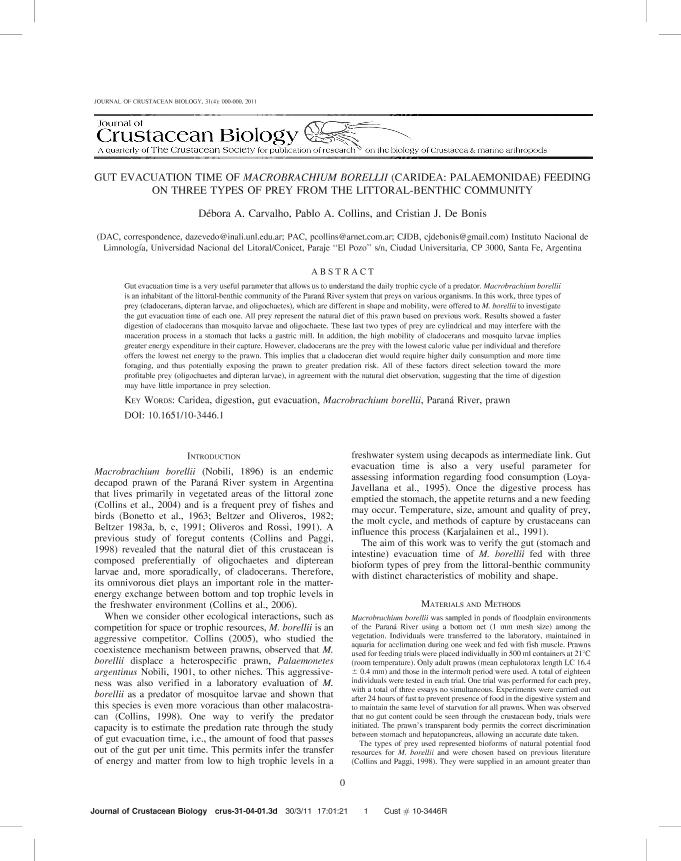Mostrar el registro sencillo del ítem
dc.contributor.author
de Azevedo Carvalho, Debora

dc.contributor.author
Collins, Pablo Agustin

dc.contributor.author
de Bonis, Cristian

dc.date.available
2019-05-11T21:14:41Z
dc.date.issued
2011-10
dc.identifier.citation
de Azevedo Carvalho, Debora; Collins, Pablo Agustin; de Bonis, Cristian; Gut evacuation time of macrobrachium borellii (Caridea: Palaemonidae) feeding on three types of prey from the littoral-benthic community; Crustacean Society; Journal of Crustacean Biology; 31; 4; 10-2011; 630-634
dc.identifier.issn
0278-0372
dc.identifier.uri
http://hdl.handle.net/11336/76138
dc.description.abstract
Gut evacuation time is a very useful parameter that allows us to understand the daily trophic cycle of a predator. Macrobrachium borellii is an inhabitant of the littoral-benthic community of the Paran River system that preys on various organisms. In this work, three types of prey (cladocerans, dipteran larvae, and oligochaetes), which are different in shape and mobility, were offered to M. borellii to investigate the gut evacuation time of each one. All prey represent the natural diet of this prawn based on previous work. Results showed a faster digestion of cladocerans than mosquito larvae and oligochaete. These last two types of prey are cylindrical and may interfere with the maceration process in a stomach that lacks a gastric mill. In addition, the high mobility of cladocerans and mosquito larvae implies greater energy expenditure in their capture. However, cladocerans are the prey with the lowest caloric value per individual and therefore offers the lowest net energy to the prawn. This implies that a cladoceran diet would require higher daily consumption and more time foraging, and thus potentially exposing the prawn to greater predation risk. All of these factors direct selection toward the more profitable prey (oligochaetes and dipteran larvae), in agreement with the natural diet observation, suggesting that the time of digestion may have little importance in prey selection.
dc.format
application/pdf
dc.language.iso
eng
dc.publisher
Crustacean Society

dc.rights
info:eu-repo/semantics/openAccess
dc.rights.uri
https://creativecommons.org/licenses/by-nc-sa/2.5/ar/
dc.subject
CARIDEA
dc.subject
DIGESTION
dc.subject
GUT EVACUATION
dc.subject
MACROBRACHIUM BORELLII
dc.subject
PARANÁ RIVER
dc.subject
PRAWN
dc.subject.classification
Otras Ciencias Biológicas

dc.subject.classification
Ciencias Biológicas

dc.subject.classification
CIENCIAS NATURALES Y EXACTAS

dc.title
Gut evacuation time of macrobrachium borellii (Caridea: Palaemonidae) feeding on three types of prey from the littoral-benthic community
dc.type
info:eu-repo/semantics/article
dc.type
info:ar-repo/semantics/artículo
dc.type
info:eu-repo/semantics/publishedVersion
dc.date.updated
2019-05-07T20:25:08Z
dc.identifier.eissn
1937-240X
dc.journal.volume
31
dc.journal.number
4
dc.journal.pagination
630-634
dc.journal.pais
Estados Unidos

dc.journal.ciudad
Lawrence
dc.description.fil
Fil: de Azevedo Carvalho, Debora. Consejo Nacional de Investigaciones Científicas y Técnicas. Centro Científico Tecnológico Conicet - Santa Fe. Instituto Nacional de Limnología. Universidad Nacional del Litoral. Instituto Nacional de Limnología; Argentina
dc.description.fil
Fil: Collins, Pablo Agustin. Consejo Nacional de Investigaciones Científicas y Técnicas. Centro Científico Tecnológico Conicet - Santa Fe. Instituto Nacional de Limnología. Universidad Nacional del Litoral. Instituto Nacional de Limnología; Argentina
dc.description.fil
Fil: de Bonis, Cristian. Consejo Nacional de Investigaciones Científicas y Técnicas. Centro Científico Tecnológico Conicet - Santa Fe. Instituto Nacional de Limnología. Universidad Nacional del Litoral. Instituto Nacional de Limnología; Argentina
dc.journal.title
Journal of Crustacean Biology

dc.relation.alternativeid
info:eu-repo/semantics/altIdentifier/doi/http://dx.doi.org/10.1651/10-3446.1
Archivos asociados
